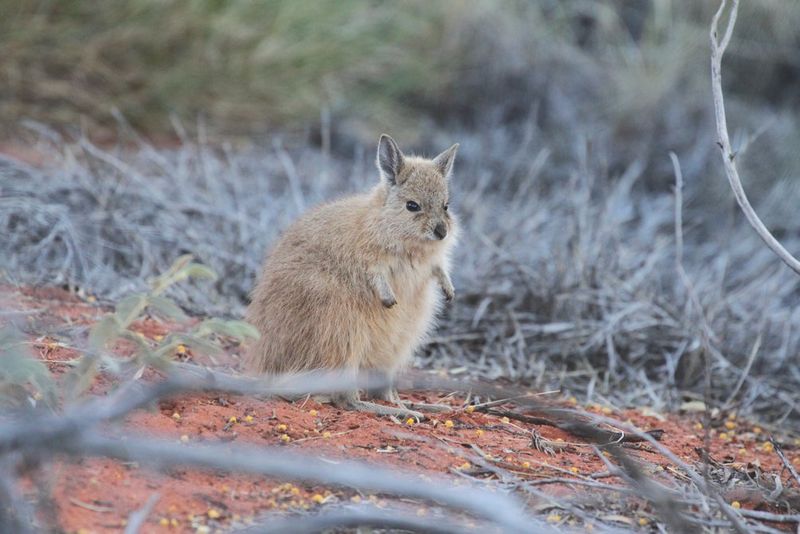Conservation
Our rangers use a mix of traditional knowledge and modern science to conserve the plants, animals, Culture and landscapes of Uluṟu-Kata Tjuṯa National Park.
Fire management - Cultural burning
Using fire has been a part of land management and Tjukurpa for thousands of years. Aṉangu, the Traditional Owners of Uluṟu-Kata Tjuṯa National Park, have lived on and managed this Country for more than 30,000 years. Knowledge gained about traditional fire management is contained in Tjukurpa, taught through generations from grandparents, and passed down, and is learnt by being out on Country.
Tjukurpa stories talk about the beginning of time when Ancestral Beings first created the world. These stories contain important lessons about the land and how to survive in the desert, as well as rules for appropriate behaviour.
Many of our plants rely on fire to regenerate. Burning encourages bush foods to grow and flushes out game animals, ensuring that Aṉangu have plenty to eat.
Burning also reduces fuel loads, preventing the risk of large wildfires. Before Europeans arrived in the Uluṟu-Kata Tjuṯa region, traditional patch burning produced a mosaic-like pattern of burnt and unburnt terrain, making it difficult for small fires to spread and become big ones.
Patch burning stopped when many Traditional Owners were removed from the region in the 1930s, and we quickly saw the result of having no fire regime in place.
During the 1940s rainfall was good and plants flourished. But in 1950, a fire fed by fuel from 20 years of uninhibited growth burnt about a third of the park’s vegetation. In 1976, two more fires burnt out more than 75% of the park.
Park managers realised that they needed a different approach to fire management – one that relied on techniques that have worked for many thousands of years. The park managers approached Traditional Owners and together they developed a system of patch burnings for use in the park.
The traditional lands of Aṉangu cover a huge area that stretches beyond Uluṟu-Kata-Tjuṯa National Park. As fires can travel a long distance, it’s important that everyone works together to manage and protect Aṉangu Country. This burning regime continues today with Traditional Owners guiding rangers to improve the health of the park. Patch burning takes place in winter when temperatures are low and the winds are light.
Mala conservation – caring for Culture and Country

Mala in the park
A long time, a group of Aṉangu ancestors – the Mala people – travelled to Uluṟu from the north.
Today, park rangers and Aṉangu work together to look after the animal we now call the mala.
Mala (also known as rufous hare-wallabies) once inhabited spinifex grass country throughout Central Australia. Wild mala are now extinct in the area, driven out by European settlement, changing fire regimes and feral predators.
Since 2005, we have been running a mala reintroduction program in Uluṟu-Kata Tjuṯa National Park. Working together with Aṉangu from Muṯitjulu community, we constructed a 170-hectare feral-proof enclosure to house a group of these endangered animals so they can breed and contribute to the long-term survival of the species. Today we have a healthy and robust community of mala in the park.
The mala program is just one example of how Parks Australia works with Traditional Owners to protect the natural and cultural heritage of Uluṟu-Kata Tjuṯa.
Feral animal management
Central Australia’s desert environments are incredibly sensitive, and introduced animals can do a lot of damage.
The main feral animals that cause problems in Uluṟu-Kata Tjuṯa National Park are camels, rabbits, foxes and cats. These species can drain scarce water sources, kill native animals and eat plants that are important for ecosystem health.
There are no fences around the park, so we work with our neighbours across the region to control feral animals.
We work together with Aṉangu through consultation on management plans and drawing on knowledge and tracking skills to control introduced species.
Weed management
By far the most invasive weed we manage in the park is buffel grass. Buffel grass is a perennial tussock grass native to Africa, India and Asia.
It was first introduced to the deserts of Australia in the 1870s, for erosion control pastoral purposes, and has since spread widely across most land types. Its seeds can be easily spread by wind, water, cattle or camels and machinery.
The problem with buffel grass is it chokes out native grasses, destroying habitat for our native animals. It provides further fuel for wildfires in areas not previously burnt, especially in our mulga shrublands.
Currently our management consists of removing buffel grass by hand, a resource-intensive process. We have been fortunate that many people have volunteered to help us with this work. In 2012 our rangers began trialling other methods of control, including different burning and herbicide combinations. This helped inform our longer-term buffel management plan.

